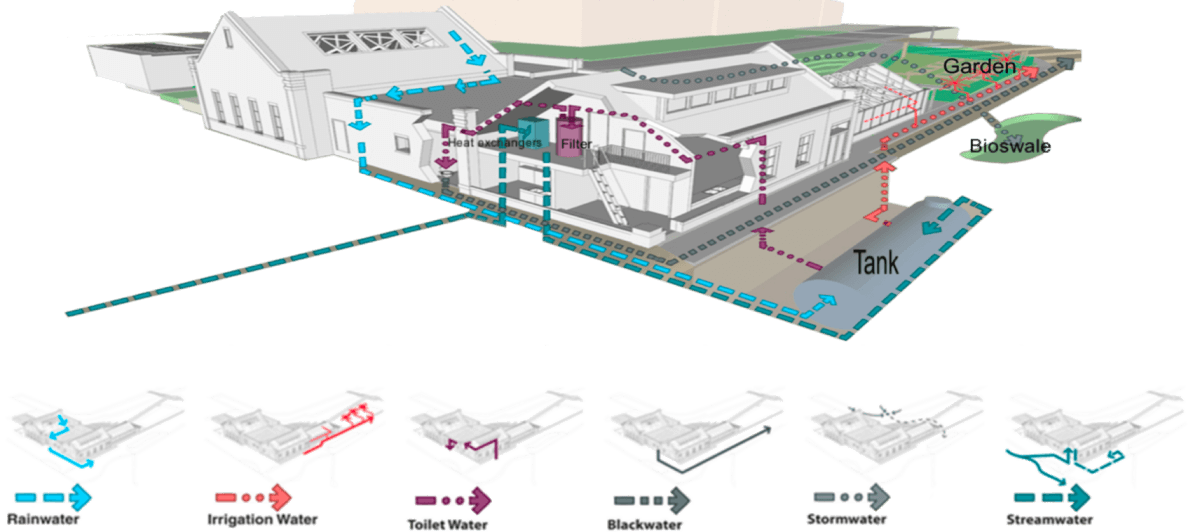As we all know, the Australian National University (ANU) is currently in the early stages of a major redevelopment of Union Court. I believe that quite a few people are frustrated by the site fencing and campus construction. However, the revitalisation of Union Court will be beneficial for everyone in the future. This is because sustainability has been identified as an indispensable element of Reunion Court Redevelopment.
The aims of the ‘Reimagine Our ANU’ project centre on using sustainability to ‘shift our thinking’ and ‘create a shared vision for success’. This makes sense as it has been widely recognised that sustainability can contribute to the economic, social and environmental wellbeing of communities.
Although these aims are admirable, there are some practical flaws evident in the implementation of the Redevelopment strategy. As an environmental science student, I’ve noticed the space for a water recycling system. A water recycling system is essential in contributing to the sustainable revitalisation of the Union Court redevelopment. Essentially, water recycling is a process that recovers wastewater for further beneficial purposes.
There are six operation lines of a water recycling system:
1. Rainwater falls onto rooftops which is collected in a tank (Shown in blue)
2. Water stored in the tank is be used to irrigate fields and gardens (Shown in orange)
3. Water stored in the tank is be filtered and used for toilets (Shown in purple)
4. Water from toilets is sent to local sewage treatment plants (shown in dark grey)
5. Stormwater is collected on site from roads, paths and sidewalks, which will be treated in the bioswale and used for irrigation (Shown in light grey)
6. Stream water delivered from ANU Sullivan’s Creek travels through a heat exchanger and is then be stored in a tank for irrigation purpose (shown in dark blue)
So, how does a water recycling system enhance the sustainability of Reunion Court? The water recycling system enhances the sustainability of Reunion Court in three dimensions: by improving economic, ecological, social and educational aspects of the university.
Economic Benefits
The water recycling project saves ANU significant expenditure on water usage and waste disposal by capitalising on wastewater within the pre-existing water usage loop. As outlined above, the mechanism of this system allows for savings in a range of areas. By using treated storm water collected on site from roads, paths and sidewalks efficiency is increased. Water can also be delivered faster from Sullivan’s Creek via the process of travelling through a heat exchanger to increase the flow rate. All of this water can be stored in a tank and used for toilets, and the irrigation of fields and gardens – keeping the grounds of ANU greener with less expenditure on water usage.
Social and educational benefits
This water recycling program provides ANU with an opportunity to gain public recognition for its efforts on water saving. Subsequently, this builds or enhances ANU students’ sense of belonging.
Given the fact that Australia is one of the driest continents on earth, yet its residents are one of the highest consumers of water per person, it is crucial to raise students’ awareness of the importance of water usage. This water recycling system can be introduced to new students through a half-hour talk and tour in orientation week. Educational and eye-catching signs can be posted in toilets and garden areas to remind students that the water being used is recycled water.
We should also utilise our sustainability unit: collaboration with ANUgreen could result in the creation of a campus app about this water recycling project. This app could show the real-time working process and corresponding benefits of this water recycling system, helping students understand that recycling water does make a difference.
The aspirations of students play a key role in shaping our future. Ultimately sustainable initiatives on campus arm students with the ability to take on future challenges concerned with finite resources and environmental changes. The lessons students learn can set habits for a lifetime, and most importantly, this water recycling system could impact students, their families and the overall waste diversion of a community.
Ecological Benefits
This water recycling system enables ANU to actively promote ecological conservation. By providing additional sources of water, the system contributes to water savings through water reuse for irrigation and toilet flushing. Moreover, the water recycling system could also decrease wastewater discharge and prevent potential pollution. The system ensures that wastewater from toilets is sent to local sewage treatment instead of the local environment. Most importantly, the ability of the system to recycle water could enhance biodiversity. Treated water will be sent to rivers, which keeps them flowing and able to support aquatic life during the many dry periods experienced in Canberra.
It is clear that a water recycling system would make important contributions to the economic, social and ecological sustainability of our campus. Therefore, it should be a vital part of the Reunion Court Redevelopment. I invite readers, like you, to think about and discuss what other ideas you think will contribute to a more sustainable ANU.
We acknowledge the Ngunnawal and Ngambri people, who are the Traditional Custodians of the land on which Woroni, Woroni Radio and Woroni TV are created, edited, published, printed and distributed. We pay our respects to Elders past and present. We acknowledge that the name Woroni was taken from the Wadi Wadi Nation without permission, and we are striving to do better for future reconciliation.
